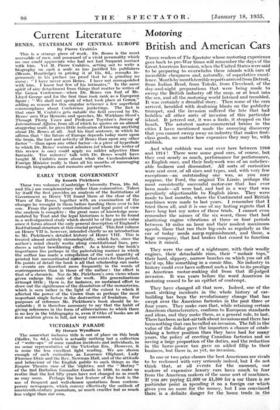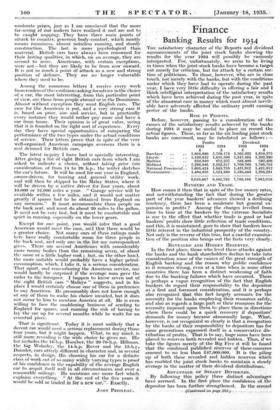Motoring
British and American Cars
THOSE readers of The Spectator whose motoring experience goes back to pre-War times will remember the days of the Great American Invasion, when the United States were said to be preparing to overwhelm these islands with cars of incredible cheapness and, naturally, of superlative excel= lenee. Month by month terrible reports arrived from Detroit, from Indian Bend, from Toledo, from Cleveland, of the day-and-night preparations that were being made to sweep the British industry off the map, or at least into the sea, and all the motoring world listened and trembled. It was Certainly a dreadful story. Then some of the cars arrived, heralded with deafening blasts on the publicity trumpet, and the invasion suffered the fate that had befallen all other sorts' of invasion of this particular island. It petered out, it was a fizzle, it stopped on the beach. The astutest motor-commercial brains in the cities I have mentioned made the annoying discovery that you cannot sweep away an industry that makes first- class goods, no matter how expensive they may be, with rubbish.
And what rubbish was sent over here between 1910 and 1914 ! There were some good cars, of course, but they cost nearly as much, performance for performance, as English ones, and their bodywork was of an unbeliev- able badness and discomfort. All sorts of curiosities were sent over, of all sizes and types, and, with very few exceptions—an outstanding one was, as you may suppose, the Ford, the original Tin Lizzie, perhaps the most consistently successful motor-car that has ever been made—all were bad, and bad in a way that was peculiarly objectionable to English ideas. They were made to last months, where the Continental and British machines were made to last years. I remember that I tried them all, and it is one of my lasting regrets that I have long lost my notes of those trials. I cannot even remember the names of the six worst, those that had shattering engine vibrations at three • or four' periods between 10 miles an hour and their modest maximum speeds, those that ran their big-ends as regularly as the car of today- needs sump-replenishment, and those, a huge company, that had brakes that ceased to function when it rained.
They were the cars of a nightmare, with their woolly engines, their detachable rims, their " mohair tops," their hard, slippery, narrow benches on which you sat all tee'd up, like something in a comic film. No industry in history could ever have suffered such a blow to its prestige as American motor-making did from that ill-judged invasion. It was years before the word American in motoring ceased to be an epithet of contempt.
They have changed all that now. Indeed, one of the most striking incidents in the whole history of car- building has been the revolutionary change that has swept over. the. American factories in the past three or four years. They make cars that, while retaining certain American characteristics, conform to European standards and ideas, and they make them, as a general rule, to last. There has been no hot-air talk about invasions and there has been nothing that can be called an invasion. The fall in the value of the dollar gave the iniporters a chance of estab- lishing a better position than they have had for many years, the policy of erecting Canadian factories and so saving a large proportion of the duties, and the reduction in the horse-power tax gave an added fillip to their business, but there is, as yet, no invasion.
In one or two price classes the best Americans are rivals to be reckoned with very seriously indeed, but I do not think that, at all events for the moment, our makers of expensive luxury ears have much to fear from the American makers of the same sort of machines. If you are paying £1,000 or £1,500 for a car there is no particular point in spending it on a foreign car which gives you no more for the money, but I am convinced there is a definite danger for the home trade in the moderate. prieesj just as I am convinced that the more far-seeing. of our makers have realized it and are not to be caught napping. They have three main points of attack to Counter,"generbuS, body-comfort, which mostly means roominess, almost noiseless running, and sturdy construction. - The • last. is more psychological - than material. British cars have always been renowned ,for their lating qualitieg; in Which, on an average, they are second to none; Americans, with certain exceptions, were not—but they are likely to be from now onward. It is not so much a point of attack as a new and strong position of defence. Their are no longer Vulnerable where they used to be.
Among the numerous letters I receive every week from readers of these colunins asking for advice in the choiee of a car, the most interesting, from thiS particular point of view, are those from people abroad or in the Dominions. Almost without exception they:want English cars.. The case for the American is put, and a very strong case it is, based on price, size and service, but in practically every instance they would *rather pay more and have a car from home. Their opinion is of great value, seeing that it is founded on the right sort of experience. - Every day they have special opportunitieS of comparing the performance of the two types under the actual conditions of service. Their letters prove that in spite Of the very well-organized American campaign overseas there is a real demand for British cars.
The latest inquiry I have had is specially interesting. After giving a list of eight British cars from which I am asked to indicate a choice, without taking price into consideration, of from 14 to 20 h.p:, the writer sketches the ear's future. It will be used for one year in England, owner-driven, for touring and general utility work, and will then be shipped °to the Malay States, where it will be driven by a native driver for four years, about 10,000 or 12,000 miles a year. " Garage service will be available within a few miles, and it would not matter greatly if spares had to be obtained from England on any occasion." It must acconmiodate three people on' the back seat, and must do about 20 miles to the gallon. It need not be very fast, but it must be comfortable and quiet in running, especially on the lower gears.
Except for one point, you Would infer that a good American would meet the case, and that there would be a greater choice. Not many cars of these, ratings made here' have really comfortable room for three people in the back seat, and only one in the list my correspondent gives. There are several Amerieans with considerably more roomy bodies than the remaining seven, -at about the same or a little higher Coat ;- but, on the Other hand, the more suitable would probably have a _higher petrol- consumption, which, I take it, is a serious: consideration. That apart, and remembering the American service, one would hardly be surprised if the average man gave the order to the foreigner. I happen to know seven out of the eight British cars " Malaya " suggests, and in his place I would certainly choose one of them in preference to any American. He presumably does not know enough of any of them to make his choice unaided, but it does not occur to him to mention America at all. He is even willing to face the maddening business of sending to England for spares, and running the risk of having to lay the car up for several months while he waits for an essential piece.
That is significant. Today it is most unlikely that a decent car would need a serious: replacement during those four years, but it might happen. What, to my mind, is still more revealing is the wide choice he gives me. His list includes the 16-h.p. Humber, the 20-70-h.p. Hillman, the big Wolseley, the 14-h.p. Rover and the 15-h.r. Daimler, cars utterly different -in character and, in several respects, in design. His choosing his car for a definite class of work out of so many Widely varying types is proof of his confidence in the capability of the average English car to acquit itself well in all -circumstances and over a; reasonable mileage. He mentions one more fact which explains everything. " At the end of -the five years it would be sold or traded in for a -new car.".. Exactly..
JOHN PliI0LEAU.







































 Previous page
Previous page